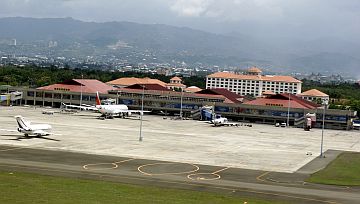
The Mactan-Cebu International Airport expansion project is set to start soon. | CDN File Photo
CEBU CITY, Philippines – The Mactan-Cebu International Airport Authority (MCIAA) has reaffirmed its support for the local business community despite plans to relocate the Mactan Economic Zone (MEZ) in Lapu-Lapu City to give way to the construction of a parallel runway.
MCIAA General Manager Steve Dicdican said that the transfer of 150 MEZ-1 locators to a nearby reclamation area is a win-win solution that is expected to bolster local economic activities even far beyond the economic zone. He added that the airport and its expansion is there to support the entire island of Cebu, including its business community.
In a press statement released today, September 18, Dicdican said that MCIA has more than doubled its passenger traffic to 13 million passengers in 2019 from only 6 million passengers in 2015. The increase in passenger count is expected to redound in more economic activity for local residents and businesses including those located in Philippine Economic Zone Authority (PEZA) areas.
“Because of our ideal mix of geography, culture and people, Cebu is growing at a phenomenal rate and will continue to grow in the decades to come. We can either ignore the growth and be overwhelmed by its effects at a later time or proactively plan and build now so we can support the growth. We have chosen to plan ahead. Our proposed new home for MEZ-1 will be a ‘smart city’, boasting state-of-the-art facilities that will maximize the capacity for production of companies especially those in the information technology industry,” he said.
Dicdican added that “from the relocation area, locators will have direct access to a proposed cargo terminal in the airport. Aside from this, shared services infrastructure and renewable resources (solar power, rainwater harvesting, etc.) will be made available, providing locators with many opportunities to reduce operational costs.”
He cited the Atlanta International Airport’s development of an additional 2.74 kilometer runway that required various businesses to relocate. “The whole project was tremendously complex and caused some degree of disruption, but ultimately, businesses continued to thrive.”
The airport expansion in Atlanta generated a much bigger impact, allowing passenger traffic to increase by an additional 15 million passengers per annum in 2015. Atlanta airport’s new runway also increased the efficiency of the aircraft movements resulting in an overall higher airline on-time rate of over 82 percent from 71 percent before the new runway’s opening.
Dicdican said that the timeline for the 2nd runway project including its reclamation component is spread over seven to 10 years. He added that the process will be long-drawn giving MEZ locators more than enough time and preparation for the relocation and ensure minimal disruption.
“While we will take into consideration and attempt to address all the concerns of the stakeholders, we have to make necessary sacrifices to sustain our long-term prospects and promote the greater good of the Cebuanos. We have looked at all the angles and all the scenarios. The relocation of MEZ-1 remains the most viable solution for all involved and the best implementation strategy for the 2nd runway.” | dcb